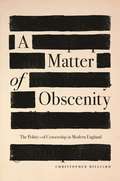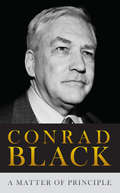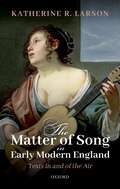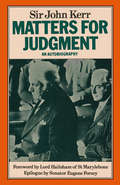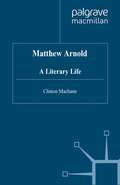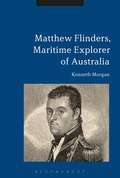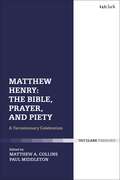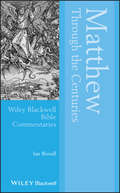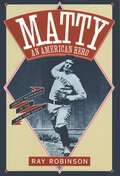- Table View
- List View
A Matter of Obscenity: The Politics of Censorship in Modern England
by Christopher HilliardA comprehensive history of censorship in modern BritainFor Victorian lawmakers and judges, the question of whether a book should be allowed to circulate freely depended on whether it was sold to readers whose mental and moral capacities were in doubt, by which they meant the increasingly literate and enfranchised working classes. The law stayed this way even as society evolved. In 1960, in the obscenity trial over D. H. Lawrence's Lady Chatterley's Lover, the prosecutor asked the jury, "Is it a book that you would even wish your wife or your servants to read?" Christopher Hilliard traces the history of British censorship from the Victorians to Margaret Thatcher, exposing the tensions between obscenity law and a changing British society.Hilliard goes behind the scenes of major obscenity trials and uncovers the routines of everyday censorship, shedding new light on the British reception of literary modernism and popular entertainments such as the cinema and American-style pulp fiction and comic books. He reveals the thinking of lawyers and the police, authors and publishers, and politicians and ordinary citizens as they wrestled with questions of freedom and morality. He describes how supporters and opponents of censorship alike tried to remake the law as they reckoned with changes in sexuality and culture that began in the 1960s.Based on extensive archival research, this incisive and multifaceted book reveals how the issue of censorship challenged British society to confront issues ranging from mass literacy and democratization to feminism, gay rights, and multiculturalism.
A Matter of Principle
by Conrad BlackIn 1993, Conrad Black was the proprietor of London's Daily Telegraph and the head of one of the world's largest newspaper groups. In 2004, however, he was accused of fraud and fired as chairman of Hollinger. In A Matter of Principle, Black describes his indictment, four-month trial, partial conviction, imprisonment and largely successful appeal. Black writes without reserve about the prosecutors who mounted a campaign to destroy him and the journalists who presumed he was guilty. Fascinating people fill these pages, from prime ministers and presidents to the social, legal and media elite. Woven throughout are Black's views on big themes: politics, corporate governance and the US justice system. He is candid about highly personal subjects, including his friendships, his faith and his marriage to Barbara Amiel. Above all, Black maintains his innocence and recounts what he describes as the 'fight of and for my life'. A Matter of Principle is a riveting memoir and a scathing account of a flawed justice system.
The Matter of Song in Early Modern England: Texts in and of the Air
by Katherine R. LarsonGiven the variety and richness of the sixteenth- and seventeenth-century English 'songscape', it might seem unsurprising to suggest that early modern song needs to be considered as sung. When a reader encounters a song in a sonnet sequence, a romance, and even a masque or a play, however, the tendency is to engage with it as poem rather than as musical performance. Opening up the notion of song from a performance-based perspective, The Matter of Song in Early Modern England considers the implications of reading song not simply as lyric text but as an embodied and gendered musical practice. Animating the traces of song preserved in physiological and philosophical commentaries, singing handbooks, poetic treatises, and literary texts ranging from Mary Sidney Herbert's Psalmes to John Milton's Comus, the book confronts song's ephemerality, its lexical and sonic capriciousness, and its airy substance. These features can resist critical analysis but were vital to song's affective workings in the early modern period. The volume foregrounds the need to attend much more closely to the embodied and musical dimensions of literary production and circulation in sixteenth- and seventeenth-century England. It also makes an important and timely contribution to our understanding of women's engagement with song as writers and as performers. A companion recording of fourteen songs featuring Larson (soprano) and Lucas Harris (lute) brings the project's innovative methodology and central case studies to life.
The Matter of the Heart: A History of the Heart in Eleven Operations
by Thomas Morris'Thrilling... The “dizzying” story of heart surgery is every bit as important as that of the nuclear, computer or rocket ages. And now it has been given the history it deserves' James McConnachie, Sunday TimesFor thousands of years the human heart remained the deepest of mysteries; both home to the soul and an organ too complex to touch, let alone operate on. Then, in the late nineteenth century, medics began going where no one had dared go before. In eleven landmark operations, Thomas Morris tells us stories of triumph, reckless bravery, swaggering arrogance, jealousy and rivalry, and incredible ingenuity, from the trail-blazing ‘blue baby’ procedure to the first human heart transplant. The Matter of the Heart gives us a view over the surgeon’s shoulder, showing us the heart’s inner workings and failings. It describes both a human story and a history of risk-taking that has ultimately saved millions of lives.
The Matter of the Mind: Philosophical Essays on Psychology, Neuroscience and Reduction
by Maurice Schouten Huib Looren De JongThe Matter of the Mind addresses and illuminates the relationship between psychology and neuroscience by focusing on the topic of reduction. Written by leading philosophers in the field Discusses recent theorizing in the mind-brain sciences and reviews and weighs the evidence in favour of reductionism against the backdrop of recent important advances within psychology and the neurosciences Collects the latest work on central topics where neuroscience is now making inroads in traditional psychological terrain, such as adaptive behaviour, reward systems, consciousness, and social cognition.
Matters of Communication - Formen und Materialitäten gestalteter Kommunikation (Design #48)
by Sabine Foraita Bianca Herlo Axel VogelsangDas Verhältnis von Gestaltung und Kommunikation wird heute neu befragt. Mit einem gesellschaftlichen Wandel entstehen neue Kommunikationsmedien, -kanäle, -räume und -systeme. Maschinen, Objekte, ja ganze Umgebungen werden zu eigenständigen Akteuren, die mit uns kommunizieren und auf diversen medialen Ebenen in Interaktion treten. Wie sind die Kontexte, Möglichkeitsbedingungen und Wirkungszusammenhänge gestalteter Kommunikation - ob in Bezug auf Raum, Bild, Text, Objekt oder System - heute zu verorten? »Matters of Communication« fragt danach, wie Kommunikation heute gestaltet wird, und wie Gestaltung heute kommuniziert.
Matters of Engagement: Emotions, Identity, and Cultural Contact in the Premodern World
by Daniela Hacke; Claudia Jarzebowski; and Hannes ZieglerBy drawing on a broad range of disciplinary and cross-disciplinary expertise, this study addresses the history of emotions in relation to cross-cultural movement, exchange, contact, and changing connections in the later medieval and early modern periods. All essays in this volume focus on the performance and negotiation of identity in situations of cultural contact, with particular emphasis on emotional practices. They cover a wide range of thematic and disciplinary areas and are organized around the primary sources on which they are based. The edited volume brings together two major areas in contemporary humanities: the study of how emotions were understood, expressed, and performed in shaping premodern transcultural relations, and the study of premodern cultural movements, contacts, exchanges, and understandings as emotionally charged encounters. In discussing these hitherto separated historiographies together, this study sheds new light on the role of emotions within Europe and amongst non-Europeans and Europeans between 1100 and 1800. The discussion of emotions in a wide range of sources including letters, images, material culture, travel writing, and literary accounts makes Matters of Engagement an invaluable source for both scholars and students concerned with the history of premodern emotions.
Matters of Engagement: Emotions, Identity, and Cultural Contact in the Premodern World
by Daniela Hacke Claudia Jarzebowski Hannes ZieglerBy drawing on a broad range of disciplinary and cross-disciplinary expertise, this study addresses the history of emotions in relation to cross-cultural movement, exchange, contact, and changing connections in the later medieval and early modern periods. All essays in this volume focus on the performance and negotiation of identity in situations of cultural contact, with particular emphasis on emotional practices. They cover a wide range of thematic and disciplinary areas and are organized around the primary sources on which they are based. The edited volume brings together two major areas in contemporary humanities: the study of how emotions were understood, expressed, and performed in shaping premodern transcultural relations, and the study of premodern cultural movements, contacts, exchanges, and understandings as emotionally charged encounters. In discussing these hitherto separated historiographies together, this study sheds new light on the role of emotions within Europe and amongst non-Europeans and Europeans between 1100 and 1800. The discussion of emotions in a wide range of sources including letters, images, material culture, travel writing, and literary accounts makes Matters of Engagement an invaluable source for both scholars and students concerned with the history of premodern emotions.
Matters of Revolution: Urban Spaces and Symbolic Politics in Berlin and Warsaw After 1989 (The Refiguration of Space)
by Dominik BartmanskiSymbols matter, and especially those present in public spaces, but how do they exert influence and maintain a hold over us? Why do such materialities count even in the intensely digitalized culture? This book considers the importance of urban symbols to political revolutions, examining manifold reasons for which social movements necessitate the affirmation or destruction of various material icons and public monuments. What explains variability of life cycles of certain classes of symbols? Why do some of them seem more potent than others? Why do people exhibit nostalgic attachments to some symbols of the controversial past and vehemently oppose others? What nourishes and threatens the social life of icons? Through comparative analyses of major iconic processes following the epochal revolution of 1989 in Berlin and Warsaw, the book argues that revolutionary action needs objects and sites which concretize the transformative redrawing of the symbolic boundaries between the "sacred" and "profane," good and evil, before and after, and "progressive" and "reactionary"—the symbolic shifts that every revolution implies in theory and formalizes in practice. Public symbols ensconced within actual urban spaces provide indispensable visibility to human values and social changes. As affective topographies that externalize collective feelings, their very presence and durability is meaningful, and so are the revolutionary rituals of preservation and destruction directed at those spaces. Far from being mere gestures or token signifiers, they have their own gravity with profound cultural ramifications. This volume will appeal to sociologists, anthropologists, geographers, and social theorists with interests in urban studies, public heritage, material culture, political revolution, and social movements.
Matters of Revolution: Urban Spaces and Symbolic Politics in Berlin and Warsaw After 1989 (The Refiguration of Space)
by Dominik BartmanskiSymbols matter, and especially those present in public spaces, but how do they exert influence and maintain a hold over us? Why do such materialities count even in the intensely digitalized culture? This book considers the importance of urban symbols to political revolutions, examining manifold reasons for which social movements necessitate the affirmation or destruction of various material icons and public monuments. What explains variability of life cycles of certain classes of symbols? Why do some of them seem more potent than others? Why do people exhibit nostalgic attachments to some symbols of the controversial past and vehemently oppose others? What nourishes and threatens the social life of icons? Through comparative analyses of major iconic processes following the epochal revolution of 1989 in Berlin and Warsaw, the book argues that revolutionary action needs objects and sites which concretize the transformative redrawing of the symbolic boundaries between the "sacred" and "profane," good and evil, before and after, and "progressive" and "reactionary"—the symbolic shifts that every revolution implies in theory and formalizes in practice. Public symbols ensconced within actual urban spaces provide indispensable visibility to human values and social changes. As affective topographies that externalize collective feelings, their very presence and durability is meaningful, and so are the revolutionary rituals of preservation and destruction directed at those spaces. Far from being mere gestures or token signifiers, they have their own gravity with profound cultural ramifications. This volume will appeal to sociologists, anthropologists, geographers, and social theorists with interests in urban studies, public heritage, material culture, political revolution, and social movements.
Matters of Testimony: Interpreting the Scrolls of Auschwitz
by Nicholas Chare Dominic WilliamsIn 1944, members of the Sonderkommando—the “special squads,” composed almost exclusively of Jewish prisoners, who ensured the smooth operation of the gas chambers and had firsthand knowledge of the extermination process—buried on the grounds of Auschwitz-Birkenau a series of remarkable eyewitness accounts of Nazi genocide. This careful and penetrating study examines anew these “Scrolls of Auschwitz,” which were gradually recovered, in damaged and fragmentary form, in the years following the camp’s liberation. It painstakingly reconstructs their historical context and textual content, revealing complex literary works that resist narrow moral judgment and engage difficult questions about the limits of testimony.
Matthew Arnold: A Literary Life (Literary Lives)
by C. MachannMatthew Arnold, the foremost Victorian 'man of letters', forged a unique literary career, first as an important post-Romantic poet and then as a prose writer who profoundly influenced the formation of modern literary and cultural studies. Machann challenges the popular image of Arnold as an elitist intellectual and shows how his poetry and prose grew out of his personal life and his passionate engagement with the world, emphasizing the journal publications that drove his career as a literary, social and religious critic.
Matthew Boulton: Enterprising Industrialist of the Enlightenment
by Sally BaggottMatthew Boulton was a leading industrialist, entrepreneur and Enlightenment figure. Often overshadowed through his association with James Watt, his Soho manufactories put Birmingham at the centre of what has recently been termed 'The Industrial Enlightenment'. Exploring his many activities and manufactures-and the regional, national and international context in which he operated-this publication provides a valuable index to the current state of Boulton studies. Combining original contributions from social, economic, and cultural historians, with those of historians of science, technology and art, archaeologists and heritage professionals, the book sheds new light on the general culture of the eighteenth century, including patterns of work, production and consumption of the products of art and industry. The book also extends and enhances knowledge of the Enlightenment, industrialization and the processes of globalization in the eighteenth century.
Matthew Boulton: Enterprising Industrialist of the Enlightenment
by Sally BaggottMatthew Boulton was a leading industrialist, entrepreneur and Enlightenment figure. Often overshadowed through his association with James Watt, his Soho manufactories put Birmingham at the centre of what has recently been termed 'The Industrial Enlightenment'. Exploring his many activities and manufactures-and the regional, national and international context in which he operated-this publication provides a valuable index to the current state of Boulton studies. Combining original contributions from social, economic, and cultural historians, with those of historians of science, technology and art, archaeologists and heritage professionals, the book sheds new light on the general culture of the eighteenth century, including patterns of work, production and consumption of the products of art and industry. The book also extends and enhances knowledge of the Enlightenment, industrialization and the processes of globalization in the eighteenth century.
Matthew Flinders, Maritime Explorer of Australia
by Kenneth MorganThis book provides a thoroughly researched biography of the naval career of Matthew Flinders, with particular emphasis on his importance for the maritime discovery of Australia. Sailing in the wake of the 18th-century voyages of exploration by Captain Cook and others, Flinders was the first naval commander to circumnavigate Australia's coastline. He contributed more to the mapping and naming of places in Australia than virtually any other single person. His voyage to Australia on H.M.S. Investigator expanded the scope of imperial, geographical and scientific knowledge. This biography places Flinders's career within the context of Pacific exploration and the early white settlement of Australia. Flinders's connections with other explorers, his use of patronage, the dissemination of his findings, and his posthumous reputation are also discussed in what is an important new scholarly work in the field.
Matthew Flinders, Maritime Explorer of Australia
by Kenneth MorganThis book provides a thoroughly researched biography of the naval career of Matthew Flinders, with particular emphasis on his importance for the maritime discovery of Australia. Sailing in the wake of the 18th-century voyages of exploration by Captain Cook and others, Flinders was the first naval commander to circumnavigate Australia's coastline. He contributed more to the mapping and naming of places in Australia than virtually any other single person. His voyage to Australia on H.M.S. Investigator expanded the scope of imperial, geographical and scientific knowledge. This biography places Flinders's career within the context of Pacific exploration and the early white settlement of Australia. Flinders's connections with other explorers, his use of patronage, the dissemination of his findings, and his posthumous reputation are also discussed in what is an important new scholarly work in the field.
Matthew Hawkwood Thriller Series Books 1-3: Ratcatcher, Resurrectionist, Rapscallion
by James McGeeThe Sunday Times bestselling historical thrillers. Meet Matthew Hawkwood: soldier, spy, lover. A man as dangerous as the murderers, spies and traitors he hunts on the crime-ridden streets of London at the height of the Napoleonic wars.
Matthew Henry: A Tercentenary Celebration
by Paul Middleton Matthew A. CollinsThree hundred years after his death, Matthew Henry (1662–1714) remains arguably the best known expositor of the Bible in English, due largely to his massive six-volume Exposition of the Old and New Testaments. However, Henry's famous commentary is by no means the only expression of his engagement with the Scriptures. His many sermons and works on Christian piety - including the still popular Method for Prayer - are saturated with his peculiarly practical approach to the Bible.To mark the tercentenary of Henry's death, Matthew A. Collins and Paul Middleton have brought together notable historians, theologians, and biblical scholars to celebrate his life and legacy. Representing the first serious examination of Henry's body of work and approach to the Bible, Matthew Henry: The Bible, Prayer, and Piety opens a scholarly conversation about the place of Matthew Henry in the eighteenth-century nonconformist movement, his contribution to the interpretation of the Bible, and his continued legacy in evangelical piety.
Matthew Henry: A Tercentenary Celebration
by Paul Middleton Matthew A. CollinsThree hundred years after his death, Matthew Henry (1662–1714) remains arguably the best known expositor of the Bible in English, due largely to his massive six-volume Exposition of the Old and New Testaments. However, Henry's famous commentary is by no means the only expression of his engagement with the Scriptures. His many sermons and works on Christian piety - including the still popular Method for Prayer - are saturated with his peculiarly practical approach to the Bible.To mark the tercentenary of Henry's death, Matthew A. Collins and Paul Middleton have brought together notable historians, theologians, and biblical scholars to celebrate his life and legacy. Representing the first serious examination of Henry's body of work and approach to the Bible, Matthew Henry: The Bible, Prayer, and Piety opens a scholarly conversation about the place of Matthew Henry in the eighteenth-century nonconformist movement, his contribution to the interpretation of the Bible, and his continued legacy in evangelical piety.
Matthew Through the Centuries (Wiley Blackwell Bible Commentaries)
by Ian BoxallThe reception of the Gospel of Matthew over two millennia: commentary and interpretation Matthew Through the Centuries offers an overview of the reception history of one of the most prominent gospels in Christian worship. Examining the reception of Matthew from the perspectives of a wide range of interpreters—from Origen and Hilary of Poitiers to Mary Cornwallis and Bob Marley—this insightful commentary explains the major trends in the reception of Matthew in various ecclesial, historical, and cultural contexts. Focusing on characteristically Matthean features, detailed chapter-by-chapter commentary highlights diverse receptions and interpretations of the gospel. Broad exploration of areas such as liturgy, literature, drama, film, hymnody, political discourse, and visual art illustrates the enormous impact Matthew continues to have on Judeo-Christian civilization. Known as ‘the Church’s Gospel,’ Matthew’s text has been the subject of apologetic and theological controversy for hundreds of years. It has been seen as justification for political and ecclesial status quo and as a path to radical discipleship. Matthew has influenced divergent political, spiritual, and cultural figures such as Francis of Assisi, John Ruskin, Leo Tolstoy, Dietrich Bonhoeffer, and Mahatma Gandhi. Matthew’s interest in ecclesiology provides early structures of ecclesial life, such as resolution of community disputes, communal prayer, and liturgical prescriptions for the Eucharist and baptism. A significant addition to the acclaimed Blackwell Bible Commentaries series, Matthew Through the Centuries is an indispensable resource for both students and experts in areas including religious and biblical studies, literature, history, politics, and those interested in the influence of the Bible on Western culture.
Matthew Through the Centuries (Wiley Blackwell Bible Commentaries)
by Ian BoxallThe reception of the Gospel of Matthew over two millennia: commentary and interpretation Matthew Through the Centuries offers an overview of the reception history of one of the most prominent gospels in Christian worship. Examining the reception of Matthew from the perspectives of a wide range of interpreters—from Origen and Hilary of Poitiers to Mary Cornwallis and Bob Marley—this insightful commentary explains the major trends in the reception of Matthew in various ecclesial, historical, and cultural contexts. Focusing on characteristically Matthean features, detailed chapter-by-chapter commentary highlights diverse receptions and interpretations of the gospel. Broad exploration of areas such as liturgy, literature, drama, film, hymnody, political discourse, and visual art illustrates the enormous impact Matthew continues to have on Judeo-Christian civilization. Known as ‘the Church’s Gospel,’ Matthew’s text has been the subject of apologetic and theological controversy for hundreds of years. It has been seen as justification for political and ecclesial status quo and as a path to radical discipleship. Matthew has influenced divergent political, spiritual, and cultural figures such as Francis of Assisi, John Ruskin, Leo Tolstoy, Dietrich Bonhoeffer, and Mahatma Gandhi. Matthew’s interest in ecclesiology provides early structures of ecclesial life, such as resolution of community disputes, communal prayer, and liturgical prescriptions for the Eucharist and baptism. A significant addition to the acclaimed Blackwell Bible Commentaries series, Matthew Through the Centuries is an indispensable resource for both students and experts in areas including religious and biblical studies, literature, history, politics, and those interested in the influence of the Bible on Western culture.
A Mattress Maker's Daughter: The Renaissance Romance of Don Giovanni de' Medici and Livia Vernazza (I Tatti studies in Italian Renaissance history #12)
by Brendan DooleyIn explaining an improbable liaison and its consequences, A Mattress Maker's Daughter explores changing concepts of love and romance, new standards of public and private conduct, and emerging attitudes toward property and legitimacy just as the age of Renaissance humanism gives way to the Counter Reformation and Early Modern Europe.
A Mattress Maker's Daughter: The Renaissance Romance of Don Giovanni de' Medici and Livia Vernazza (I Tatti studies in Italian Renaissance history #12)
by Brendan DooleyIn explaining an improbable liaison and its consequences, A Mattress Maker's Daughter explores changing concepts of love and romance, new standards of public and private conduct, and emerging attitudes toward property and legitimacy just as the age of Renaissance humanism gives way to the Counter Reformation and Early Modern Europe.
Matty: Christy Mathewson of the New York Giants
by Ray RobinsonWhen all-time pitching great Christy Mathewson died of tuberculosis in 1925 at the age of 45, it touched off a wave of national mourning that remains without precedent for an American athlete. The World Series was underway, and the game the day after Mathewson's death took on the trappings of a state funeral: officials slowly lowered the flag to half-mast, each ballplayer wore a black armband, and fans joined together in a chorus of "Nearer My God to Thee." Newspaper editorials recalled Mathewson's glorious career with the New York Giants, but also emphasized his unstinting good sportsmanship and voluntary service in World War I. The pitcher known to one and all as "Matty" or "Big Six" was as beloved for the strength of character he brought to the national pastime, as for his stunning 373 career victories. "I do not expect to see his like again," said his best friend and former manager, John McGraw. "But I do know that the example he set and the imprint he left on the sport that he loved and honored will remain long after I am gone." In Matty, Ray Robinson tells the story of a man who became America's first authentic sports hero. Until Mathewson, Robinson reveals, Americans loved baseball, but looked down on ballplayers and other athletes as hard-drinking, skirt-chasing ne'er-do-wells. Deprived of real-life role models, millions of readers followed the serialized exploits of Frank Merriwell, a fictional hero who excelled at sports from baseball to billiards and never drank, smoke, or swore. Robinson shows how an eager public greeted Mathewson as a flesh-and-blood version of Merriwell from his first year at Bucknell University, where he shone as star pitcher, premier field-goal kicker, and class president. Lured into the big leagues before he could graduate, the tall, handsome pitcher soon won over men, women and children with his sense of fair play and his arsenal of blazing fastballs, sweeping curves, and infamously deceptive fadeaway pitches. Robinson skillfully details the highlights of Mathewson's career, including his showdowns against the great batters of his day and his encounters with the young Brooklyn, Chicago, Pittsburgh and St. Louis teams. Here are the six remarkable days in October, 1905 when Mathewson became the only pitcher ever to hurl three straight shutouts in a World Series, and the afternoon at West Point when he won $50 in a bet that he could throw 20 of his best pitches to exactly the same spot. Robinson does not underplay Mathewson's occasional failings, but the most surprising aspect of this fascinating portrait is just how close America's first Hall of Fame pitcher came to living up to his image. Drawing on rare interviews, press clips, and long overlooked eyewitness accounts, Matty brings baseball's golden age to life--not only the great teams and the early superstars, but the long train trips between games, with cramped berths and no air conditioning; the small town ballplayers let loose amidst big city vice; and the two-bit gambling that eventually led to the infamous Black Sox Scandal of the 1919 Series (a scandal that might have escaped detection if the sportswriters in the press box with Mathewson had not been able to rely on his experienced eye for clues to how ballplayers might throw games). Offering rare insight into the making of an early twentieth century American hero, Matty is must reading for anyone who loves baseball.
